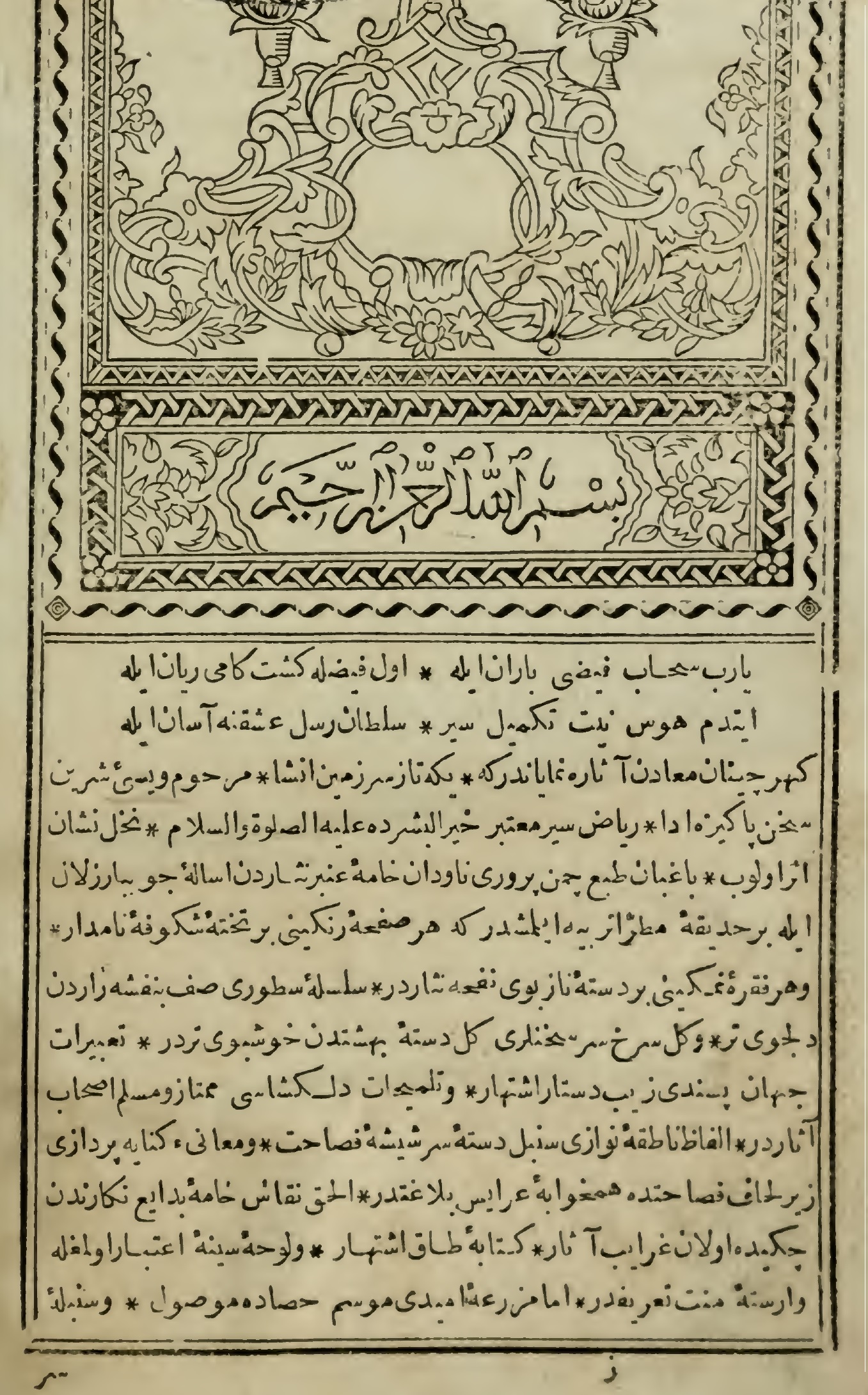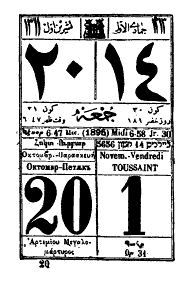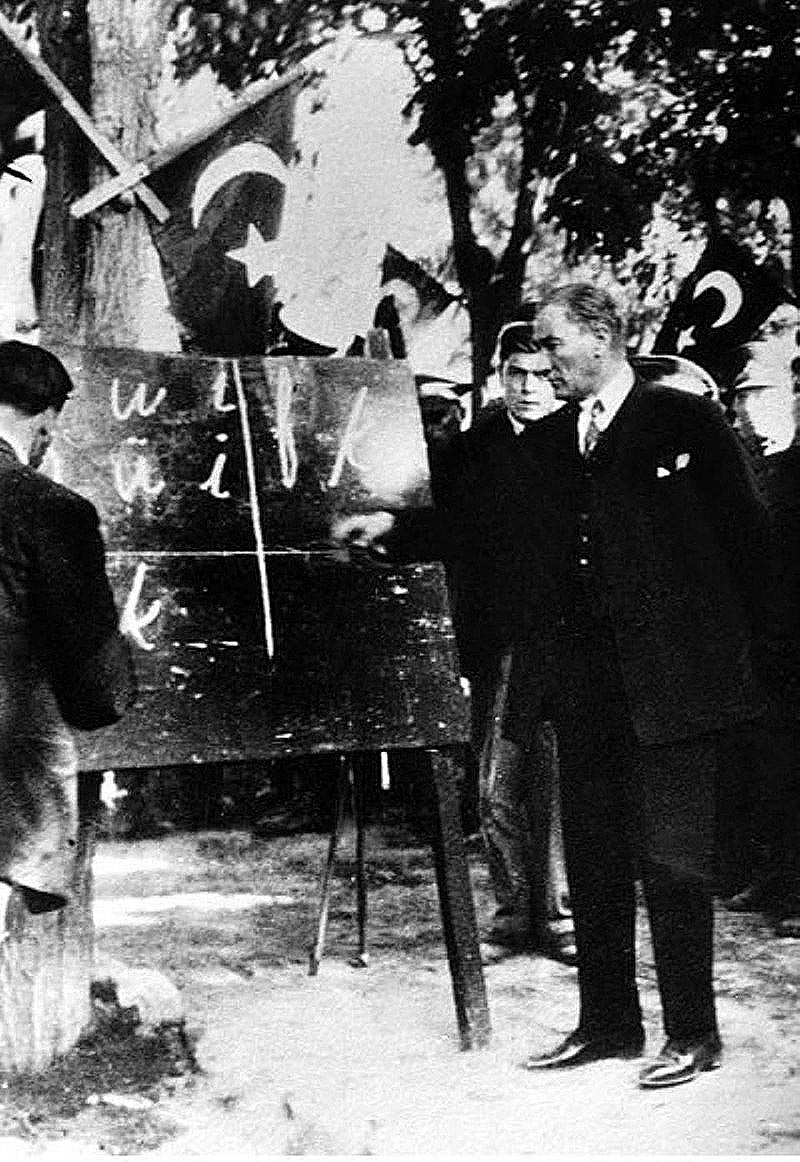Ottoman Turkish alphabet on:
[Wikipedia]
[Google]
[Amazon]
The Ottoman Turkish alphabet ( ota, الفبا, ') is a version of the Arabic script used to write 
 Some Turkish reformers promoted the Latin script well before Atatürk's reforms. In 1862, during an earlier period of reform, the statesman Münif Pasha advocated a reform of the alphabet. At the start of the 20th century, similar proposals were made by several writers associated with the Young Turk movement, including
Some Turkish reformers promoted the Latin script well before Atatürk's reforms. In 1862, during an earlier period of reform, the statesman Münif Pasha advocated a reform of the alphabet. At the start of the 20th century, similar proposals were made by several writers associated with the Young Turk movement, including
 Ottoman Turkish script was replaced by the
Ottoman Turkish script was replaced by the
full text
/ref> Arabic and Persian borrowings are written in their original orthography: for example, and if using Arabic vowel points (''harakat''), ''sabit'' 'firm' is written as ''s̱âbit'', with ''s̱'' representing /s/ (in Arabic /θ/), representing the long vowel /aː/ as in Arabic, representing /b/, representing the short vowel /i/, and representing /t/. However, as in Arabic and Persian, ''harakat'' are generally found only in dictionaries and didactic works, therefore the same word ''sabit'' will generally be found written thus: (with no indication of the short /i/). As in Persian, the alif hamza ( ''’'') is rarely used in initial position and is replaced instead by a plain alif (); the
Turkish alphabet
''Omniglot'' {{Turkish language Arabic alphabets Persian alphabets Ottoman culture Turkish language Alphabets used by Turkic languages de:Osmanische Sprache#Verschriftlichung
Ottoman Turkish
Ottoman Turkish ( ota, لِسانِ عُثمانى, Lisân-ı Osmânî, ; tr, Osmanlı Türkçesi) was the standardized register of the Turkish language used by the citizens of the Ottoman Empire (14th to 20th centuries CE). It borrowed exten ...
until 1928, when it was replaced by the Latin-based modern Turkish alphabet
The Turkish alphabet ( tr, ) is a Latin-script alphabet used for writing the Turkish language, consisting of 29 letters, seven of which ( Ç, Ğ, I, İ, Ö, Ş and Ü) have been modified from their Latin originals for the phonetic requirem ...
.
Though Ottoman Turkish was primarily written in this script, non-Muslim Ottoman subjects sometimes wrote it in other scripts, including the Armenian, Greek
Greek may refer to:
Greece
Anything of, from, or related to Greece, a country in Southern Europe:
*Greeks, an ethnic group.
*Greek language, a branch of the Indo-European language family.
**Proto-Greek language, the assumed last common ancestor ...
, Latin
Latin (, or , ) is a classical language belonging to the Italic branch of the Indo-European languages. Latin was originally a dialect spoken in the lower Tiber area (then known as Latium) around present-day Rome, but through the power ...
and Hebrew alphabet
The Hebrew alphabet ( he, אָלֶף־בֵּית עִבְרִי, ), known variously by scholars as the Ktav Ashuri, Jewish script, square script and block script, is an abjad script used in the writing of the Hebrew language and other Jewis ...
s.

History
Origins
The variousTurkic languages
The Turkic languages are a language family of over 35 documented languages, spoken by the Turkic peoples of Eurasia from Eastern Europe and Southern Europe to Central Asia, East Asia, North Asia (Siberia), and Western Asia. The Turkic l ...
have been written in a number of different alphabets, including Cyrillic, Arabic
Arabic (, ' ; , ' or ) is a Semitic language spoken primarily across the Arab world.Semitic languages: an international handbook / edited by Stefan Weninger; in collaboration with Geoffrey Khan, Michael P. Streck, Janet C. E.Watson; Walte ...
, Greek
Greek may refer to:
Greece
Anything of, from, or related to Greece, a country in Southern Europe:
*Greeks, an ethnic group.
*Greek language, a branch of the Indo-European language family.
**Proto-Greek language, the assumed last common ancestor ...
, Latin
Latin (, or , ) is a classical language belonging to the Italic branch of the Indo-European languages. Latin was originally a dialect spoken in the lower Tiber area (then known as Latium) around present-day Rome, but through the power ...
and other writing systems.
The earliest known Turkic alphabet is the Orkhon script. When Turks adopted Islam, they began to use Arabic script for their languages, especially under the Kara-Khanids. Though the Seljuks
The Seljuk dynasty, or Seljukids ( ; fa, سلجوقیان ''Saljuqian'', alternatively spelled as Seljuqs or Saljuqs), also known as Seljuk Turks, Seljuk Turkomans "The defeat in August 1071 of the Byzantine emperor Romanos Diogenes
by the Turk ...
used Persian as their official language, in the late Seljuk period, Turkish began to be written again in Anatolia in the nascent Ottoman state.
The Ottoman Turkish alphabet is a form of the Perso-Arabic script. Well suited to writing Arabic borrowings, it was poorly suited to native Turkish words: Arabic
Arabic (, ' ; , ' or ) is a Semitic language spoken primarily across the Arab world.Semitic languages: an international handbook / edited by Stefan Weninger; in collaboration with Geoffrey Khan, Michael P. Streck, Janet C. E.Watson; Walte ...
has several consonants that do not exist in Turkish, making several Arabic letters superfluous except for Arabic loanwords; conversely, some Turkish sounds are not found in Arabic, such as ''g'' and ''p''. Turkish has eight different short vowels and no long ones, whereas Arabic has three short and three long vowels; and in the Arabic script, only long vowels are normally written.
The introduction of the telegraph and the printing press in the 19th century exposed further weaknesses in the Arabic script. Zürcher, Erik Jan. ''Turkey: a modern history'', p. 188. I. B.Tauris, 2004.
 Some Turkish reformers promoted the Latin script well before Atatürk's reforms. In 1862, during an earlier period of reform, the statesman Münif Pasha advocated a reform of the alphabet. At the start of the 20th century, similar proposals were made by several writers associated with the Young Turk movement, including
Some Turkish reformers promoted the Latin script well before Atatürk's reforms. In 1862, during an earlier period of reform, the statesman Münif Pasha advocated a reform of the alphabet. At the start of the 20th century, similar proposals were made by several writers associated with the Young Turk movement, including Hüseyin Cahit
Hussein, Hussain, Hossein, Hossain, Huseyn, Husayn, Husein or Husain (; ar, حُسَيْن ), coming from the triconsonantal root Ḥ-S-i-N ( ar, ح س ی ن, link=no), is an Arabic name which is the diminutive of Hassan (given name), Hassa ...
, Abdullah Cevdet and Celâl Nuri. In 1917, Enver Pasha
İsmail Enver, better known as Enver Pasha ( ota, اسماعیل انور پاشا; tr, İsmail Enver Paşa; 22 November 1881 – 4 August 1922) was an Ottoman military officer, revolutionary, and convicted war criminal who formed one-third ...
introduced a revised alphabet, the ' representing Turkish sounds more accurately; it was based on Arabic letter forms, but written separately, not joined cursively. It was for a time the official script of the Army.
The romanization issue was raised again in 1923 during the İzmir Economic Congress of the new Turkish Republic, sparking a public debate that was to continue for several years. A move away from the Arabic script was strongly opposed by conservative and religious elements. It was argued that Romanization of the script would detach Turkey from the wider Islamic world, substituting a foreign (European) concept of national identity for the confessional community.
Others opposed Romanization on practical grounds, as there was no suitable adaptation of the Latin script that could be used for Turkish phonemes. Some suggested that a better alternative might be to modify the Arabic script to introduce extra characters for better representing Turkish vowels.
In 1926, the Turkic republics of the Soviet Union
The Soviet Union,. officially the Union of Soviet Socialist Republics. (USSR),. was a List of former transcontinental countries#Since 1700, transcontinental country that spanned much of Eurasia from 1922 to 1991. A flagship communist state, ...
adopted the Latin script, giving a major boost to reformers in Turkey.
Replacement
 Ottoman Turkish script was replaced by the
Ottoman Turkish script was replaced by the Latin
Latin (, or , ) is a classical language belonging to the Italic branch of the Indo-European languages. Latin was originally a dialect spoken in the lower Tiber area (then known as Latium) around present-day Rome, but through the power ...
-based new Turkish alphabet
The Turkish alphabet ( tr, ) is a Latin-script alphabet used for writing the Turkish language, consisting of 29 letters, seven of which ( Ç, Ğ, I, İ, Ö, Ş and Ü) have been modified from their Latin originals for the phonetic requirem ...
. Its use became compulsory in all public communications in 1929. The change was formalized by the ''Law on the Adoption and Implementation of the Turkish Alphabet'', passed on November 1, 1928, and effective on January 1, 1929.Erik Jan Zürcher (2004), ''Turkey: a Modern History'', pages 188–9.
Alphabet
As withArabic
Arabic (, ' ; , ' or ) is a Semitic language spoken primarily across the Arab world.Semitic languages: an international handbook / edited by Stefan Weninger; in collaboration with Geoffrey Khan, Michael P. Streck, Janet C. E.Watson; Walte ...
, Persian and , texts in the Ottoman Turkish alphabet are written right to left. The appearance of a letter changes depending on its position in a word:
* isolated (in a one-letter word);
* final (in which case it is joined on the right to the preceding letter);
* medial (joined on both sides); and
* initial (joined on the left to the following letter).
Some letters cannot be joined to the left and so do not possess separate medial and initial forms. In medial position, the final form is used. In initial position, the isolated form is used.
Notes
# In most texts, ''kef'', ''gef'', and ''sağır kef'' are written the same way although one Ottoman variant of ''gef'' has a "mini-''kaf''" of as well as the doubled upper stroke of . In general, /g/ and /ŋ/ sounds are represented by kef ك. The letter ڭ (kef with three dots above) also appears to be denoting the sound /g/ in Early Ottoman Turkish manuscripts, also known as ''kef-i Farisi'' ("Persian kef"). # TheLibrary of Congress
The Library of Congress (LOC) is the research library that officially serves the United States Congress and is the ''de facto'' national library of the United States. It is the oldest federal cultural institution in the country. The librar ...
recommends for ' () in a word in the construct state
In Afro-Asiatic languages, the first noun in a genitive phrase of a possessed noun followed by a possessor noun often takes on a special morphological form, which is termed the construct state (Latin ''status constructus''). For example, in Arab ...
to be romanised ' and when a word ending in ' is used adverbially, it should be romanised '.
#Persian and Ottoman use the order vāv, he, ye, though in Arabic, they are he, vāv, ye.
#One further sign, which is not considered an actual letter, is the so-called te merbūṭa ('connected t'), which can indicate the Arabic feminine singular ending and which is often also written in Ottoman texts. Te merbūṭa is always at the end
Sound–letter correspondence
The orthography of Ottoman Turkish is complex, as many Turkish sounds can be written with several different letters. For example, the phoneme /s/ can be written as , , or . Conversely, some letters have more than one value: ''k'' may be /k/, /ɡ/, /n/, /j/, or /ː/ (lengthening the preceding vowel; modern ğ), and vowels are written ambiguously or not at all. For example, the text ''kwrk'' can be read as /ɟevɾec/ 'biscuit', /cyɾc/ 'fur', /cyɾec/ 'shovel', /cøryc/ 'bellows', /ɟørek/ 'view', which in modern orthography are written ''gevrek'', ''kürk'', ''kürek'', ''körük'', ''görek''.V. H. Hagopian, ''Ottoman-Turkish Conversation-Grammar'', London and Heidelberg, 1907, p. 1-2full text
/ref> Arabic and Persian borrowings are written in their original orthography: for example, and if using Arabic vowel points (''harakat''), ''sabit'' 'firm' is written as ''s̱âbit'', with ''s̱'' representing /s/ (in Arabic /θ/), representing the long vowel /aː/ as in Arabic, representing /b/, representing the short vowel /i/, and representing /t/. However, as in Arabic and Persian, ''harakat'' are generally found only in dictionaries and didactic works, therefore the same word ''sabit'' will generally be found written thus: (with no indication of the short /i/). As in Persian, the alif hamza ( ''’'') is rarely used in initial position and is replaced instead by a plain alif (); the
ta marbuta
Taw, tav, or taf is the twenty-second and last letter of the Semitic abjads, including Phoenician Tāw , Hebrew Tav , Aramaic Taw , Syriac Taw ܬ, and Arabic ت Tāʼ (22nd in abjadi order, 3rd in modern order). In Arabic, it is also ...
(, appearing in final position of Arabic words) is also rarely used. The letters ث ح ذ ض ظ ع are found only in borrowings from Arabic; ژ is only in borrowings from Persian and French.
Consonant letters are classified in three series, based on vowel harmony
In phonology, vowel harmony is an assimilatory process in which the vowels of a given domain – typically a phonological word – have to be members of the same natural class (thus "in harmony"). Vowel harmony is typically long distance, me ...
: soft, hard, and neutral. The soft consonant letters, ت س ك گ ه, are found in front vowel (e, i, ö, ü) contexts; the hard, ح خ ص ض ط ظ ع غ ق, in back vowel (a, ı, o, u) contexts; and the neutral, ب پ ث ج چ د ذ ر ز ژ ش ف ل م ن, in either. In Perso-Arabic borrowings, the vowel used in Turkish depends on the softness of the consonant. Thus, ''klb'' 'dog' (Arabic /kalb/) is /kelb/, while ''ḳlb'' 'heart' (Arabic /qalb/) is /kalb/. Conversely, in Turkish words, the choice of consonant reflects the native vowel.
(All other sounds are only written with neutral consonant letters.)
In Turkish words, vowels are sometimes written using the vowel letters as the second letter of a syllable: ''elif'' for /a/; ''ye'' for /i/, /ɯ/; ''vav'' for /o/, /œ/, /u/, /y/; ''he'' for /a/, /e/. The corresponding ''harakat'' are there: ''üstün'' (Arabic ''fatḥah'') for /a/, /e/; ''esre'' (Arabic ''kasrah'') for /ɯ/, /i/; ''ötre'' (Arabic ''ḍammah'') for /o/, /œ/, /u/, /y/. The names of the ''harakat'' are also used for the corresponding vowels.
Other scripts
Other scripts were sometimes used by non-Muslims to write Ottoman Turkish since the Arabic alphabet was identified with Islam. The firstnovel
A novel is a relatively long work of narrative fiction, typically written in prose and published as a book. The present English word for a long work of prose fiction derives from the for "new", "news", or "short story of something new", itsel ...
to be written in the Ottoman Empire was ''Akabi'' (1851), which was written in the Armenian script by Vartan Pasha. Similarly, when the Armenian Duzian family managed the Ottoman mint during the reign of Sultan Abdülmecid I
Abdulmejid I ( ota, عبد المجيد اول, ʿAbdü'l-Mecîd-i evvel, tr, I. Abdülmecid; 25 April 182325 June 1861) was the 31st Sultan of the Ottoman Empire and succeeded his father Mahmud II on 2 July 1839. His reign was notable for the ...
( 1839–61), they kept records in Ottoman Turkish but used the Armenian script.
The Greek alphabet
The Greek alphabet has been used to write the Greek language since the late 9th or early 8th century BCE. It is derived from the earlier Phoenician alphabet, and was the earliest known alphabetic script to have distinct letters for vowels as ...
and the Rashi script of Hebrew
Hebrew (; ; ) is a Northwest Semitic language of the Afroasiatic language family. Historically, it is one of the spoken languages of the Israelites and their longest-surviving descendants, the Jews and Samaritans. It was largely preserved ...
were used by Greeks, Orthodox Turks and Jews for Ottoman. Greek-speaking Muslims would write Greek
Greek may refer to:
Greece
Anything of, from, or related to Greece, a country in Southern Europe:
*Greeks, an ethnic group.
*Greek language, a branch of the Indo-European language family.
**Proto-Greek language, the assumed last common ancestor ...
using the Ottoman Turkish script. Karamanlides
The Karamanlides ( el, Καραμανλήδες; tr, Karamanlılar), also known as Karamanli Greeks or simply Karamanlis, are a traditionally Turkish-speaking Greek Orthodox people native to the Karaman and Cappadocia regions of Anatolia.
The ...
(Orthodox Turks in Central Anatolia around Karaman region ) used Greek letters for Ottoman Turkish.
Numerals
Ottoman Turkish used Eastern Arabic numerals. The following is the list of basic cardinal numerals with the spelling in the modern Turkish alphabet:References
External links
* Simon AgerTurkish alphabet
''Omniglot'' {{Turkish language Arabic alphabets Persian alphabets Ottoman culture Turkish language Alphabets used by Turkic languages de:Osmanische Sprache#Verschriftlichung